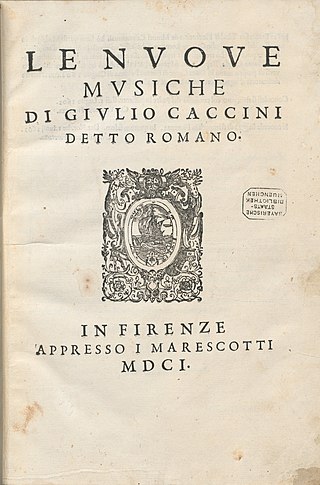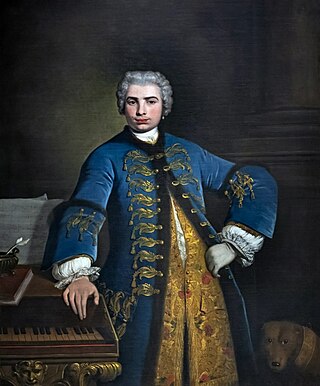The trill is a musical ornament consisting of a rapid alternation between two adjacent notes, usually a semitone or tone apart, which can be identified with the context of the trill. It is sometimes referred to by the German Triller, the Italian trillo, the French trille or the Spanish trino. A cadential trill is a trill associated with each cadence. A trill provides rhythmic interest, melodic interest, and—through dissonance—harmonic interest. Sometimes it is expected that the trill will end with a turn, or some other variation. Such variations are often marked with a few appoggiaturas following the note bearing the trill indication.

A madrigal is a form of secular vocal music most typical of the Renaissance and early Baroque (1600–1750) periods, although revisited by some later European composers. The polyphonic madrigal is unaccompanied, and the number of voices varies from two to eight, but usually features three to six voices, whilst the metre of the madrigal varies between two or three tercets, followed by one or two couplets. Unlike the verse-repeating strophic forms sung to the same music, most madrigals are through-composed, featuring different music for each stanza of lyrics, whereby the composer expresses the emotions contained in each line and in single words of the poem being sung.

In music, monody refers to a solo vocal style distinguished by having a single melodic line and instrumental accompaniment. Although such music is found in various cultures throughout history, the term is specifically applied to Italian song of the early 17th century, particularly the period from about 1600 to 1640. The term is used both for the style and for individual songs. The term itself is a recent invention of scholars. No composer of the 17th century ever called a piece a monody. Compositions in monodic form might be called madrigals, motets, or even concertos.
The Florentine Camerata, also known as the Camerata de' Bardi, were a group of humanists, musicians, poets and intellectuals in late Renaissance Florence who gathered under the patronage of Count Giovanni de' Bardi to discuss and guide trends in the arts, especially music and drama. They met at the house of Giovanni de' Bardi, and their gatherings had the reputation of having all the most famous men of Florence as frequent guests. After first meeting in 1573, the activity of the Camerata reached its height between 1577 and 1582. While propounding a revival of the Greek dramatic style, the Camerata's musical experiments led to the development of the stile recitativo. In this way it facilitated the composition of dramatic music and the development of opera.

Coloratura is an elaborate melody with runs, trills, wide leaps, or similar virtuoso-like material, or a passage of such music. Operatic roles in which such music plays a prominent part, and singers of these roles, are also called coloratura. Its instrumental equivalent is ornamentation.

Emilio de' Cavalieri, or Emilio dei Cavalieri, the spellings "del" and "Cavaliere" are contemporary typographical errors, was an Italian composer, producer, organist, diplomat, choreographer and dancer at the end of the Renaissance era. His work, along with that of other composers active in Rome, Florence and Venice, was critical in defining the beginning of the musical Baroque era. A member of the Roman School of composers, he was an influential early composer of monody, and wrote what is usually considered to be the first oratorio.
Bartolomeo Barbarino was an Italian composer and singer of the early Baroque era. He was a virtuoso falsettist, and one of the most enthusiastic composers of the new style of monody.

Giulio Romolo Caccini was an Italian composer, teacher, singer, instrumentalist and writer of the late Renaissance and early Baroque eras. He was one of the founders of the genre of opera, and one of the most influential creators of the new Baroque style. He was also the father of the composer Francesca Caccini and the singer Settimia Caccini.

Francesca Caccini was an Italian composer, singer, lutenist, poet, and music teacher of the early Baroque era. She was also known by the nickname "La Cecchina" [la tʃekˈkiːna], given to her by the Florentines and probably a diminutive of "Francesca". She was the daughter of Giulio Caccini. Her only surviving stage work, La liberazione di Ruggiero, is widely considered the oldest opera by a woman composer. As a female composer she helped to solidify the agency and the cultural and political programs of her female patron.
Settimia Caccini was a well-known Italian singer and composer during the 1600s, being one of the first women to have a successful career in music. Caccini was highly regarded for her artistic and technical work with music. She came from a family of well-known composers and singers, with her father being Giulio Caccini and her sister Francesca Caccini. Settimia Caccini was less well-known as a composer because she never published her own collection of works. Instead, nine works are attributed to her in two manuscripts of secular songs. Settimia was known much more for her talent as a singer, and she performed for nobility with the Caccini family consort and as a soloist. Coming from a musical family, she was able to lead herself to her own fame and success.
Seconda pratica, Italian for "second practice", is the counterpart to prima pratica and is sometimes referred to as Stile moderno. The term "Seconda pratica" first appeared in 1603 in Giovanni Artusi's book Seconda Parte dell'Artusi, overo Delle imperfettioni della moderna musica, where it is attributed to a certain L'Ottuso Accademico. In the first part of The Artusi (1600), Artusi had severely criticized several unpublished madrigals of Claudio Monteverdi. In the second part of this work, L'Ottuso Accademico, whose identity is unknown, defends Monteverdi and others "who have embraced this new second practice". Monteverdi adopted the term to distance some of his music from that of e.g. Giovanni Pierluigi da Palestrina and Gioseffo Zarlino and to describe early music of the Baroque period which encouraged more freedom from the rigorous limitations of dissonances and counterpoint characteristic of the prima pratica.
Giacomo Vincenti was an Italian bookseller and music printer from Venice. He also spelled his name Vincenci and Vincenzi. He started printing in 1583. His partner was Ricciardo Amadino, and between 1583 and 1586 they printed about twenty books a year, mostly editions of music. Although their official partnership ended in 1586 they continued to use the same typefaces, collaborated on some editions, and held joint copyrights in others. In 1587, Vincenti published Luca Marenzio's Fourth Book of Madrigals, with the composer's dedication.
The year 1618 in music involved some significant events.
In the years centering on 1600 in Europe, several distinct shifts emerged in ways of thinking about the purposes, writing and performance of music. Partly these changes were revolutionary, deliberately instigated by a group of intellectuals in Florence known as the Florentine Camerata, and partly they were evolutionary, in that precursors of the new Baroque style can be found far back in the Renaissance, and the changes merely built on extant forms and practices. The transitions emanated from the cultural centers of Northern Italy, then spread to Rome, France, Germany, and Spain, and lastly reached England . In terms of instrumental music, shifts in four discrete areas can be observed: idiomatic writing, texture, instrument use, and orchestration.
Chiaroscuro is part of bel canto, an originally Italian classical singing technique in which a brilliant sound referred to as squillo is coupled with a dark timbre called scuro. The overall sound is often perceived as having great depth or warmth. Chiaroscuro is commonly used in opera. Within operatic singing, especially in Italian, the vowel "Ah" provides an example of where chiaroscuro can be used: the vowel must have a bright Italian sound, as well as depth and space in the tone, which is achieved through the use of breath and the body.
Il rapimento di Cefalo was one of the first Italian operas. Most of the music was written by Giulio Caccini but Stefano Venturi del Nibbio, Luca Bati and Piero Strozzi also contributed. The libretto, by Gabriello Chiabrera, is in a prologue, five scenes and an epilogue and is based on the Classical myth of Cephalus and Aurora.
Stefano Venturi del Nibbio was an Italian composer of the late Renaissance, active in Venice and Florence. In addition to composing madrigals in a relatively conservative style, works which were published as far away as England, he collaborated with Giulio Caccini on one of the earliest operas, Il rapimento di Cefalo (1600).





